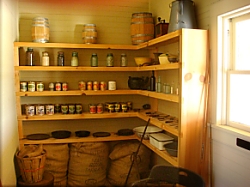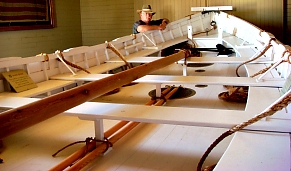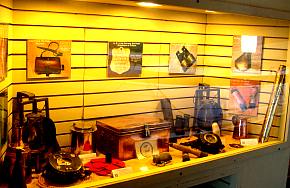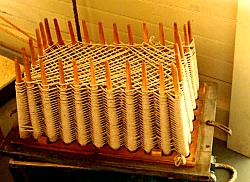A note on the wall of the kitchen explained
in part  "Food
and supplies provided by the Federal Government were only enough to sustain the
surfmen and keeper. In order to feed and clothe shipwreck survivors, the
surfmen would have to pay for the supplies themselves. This was until the
foundation of the Women's National Relief association in 1880, a group created
to provide the Life Saving Stations with additional supplies for shipwreck
victims." Other than the kitchen and pantry,
the entire rest of the bottom floor was mostly made up of the boat house. In here
was housed and maintained, the basic rescue vehicle for the life-saving station,
along with most of the support gear needed for the daring life saving
jobs. The surfboat took up most of the room. The surfboat in the
room was in service in the 1930. Although simple in
appearance, the surfboat was a
"Food
and supplies provided by the Federal Government were only enough to sustain the
surfmen and keeper. In order to feed and clothe shipwreck survivors, the
surfmen would have to pay for the supplies themselves. This was until the
foundation of the Women's National Relief association in 1880, a group created
to provide the Life Saving Stations with additional supplies for shipwreck
victims." Other than the kitchen and pantry,
the entire rest of the bottom floor was mostly made up of the boat house. In here
was housed and maintained, the basic rescue vehicle for the life-saving station,
along with most of the support gear needed for the daring life saving
jobs. The surfboat took up most of the room. The surfboat in the
room was in service in the 1930. Although simple in
appearance, the surfboat was a  complicated
design. It was an open rowboat with a wide beam. It had 6 to 8 oar
positions along with a steering position. This was usually manned by the
station keeper. Many were self-righting as well as having slits in the
deck to let the water out. Some contained ballast tanks. The 8
rowing oars were usually 12 feet long and the steering oar was 16 feet. The
boats weighed from 700 to 1000 lbs. It rode on a 4 wheel cart pulled by
the surfmen who attached ropes and a kind of shoulder harness to prevent
slipping. The boat was heavily equipped with an assortment of rescue
equipment. Mostly hooks, lines and poles. Although this room was not much bigger
than
the boat, there was still just enough room to get around and find all kinds of
things
complicated
design. It was an open rowboat with a wide beam. It had 6 to 8 oar
positions along with a steering position. This was usually manned by the
station keeper. Many were self-righting as well as having slits in the
deck to let the water out. Some contained ballast tanks. The 8
rowing oars were usually 12 feet long and the steering oar was 16 feet. The
boats weighed from 700 to 1000 lbs. It rode on a 4 wheel cart pulled by
the surfmen who attached ropes and a kind of shoulder harness to prevent
slipping. The boat was heavily equipped with an assortment of rescue
equipment. Mostly hooks, lines and poles. Although this room was not much bigger
than
the boat, there was still just enough room to get around and find all kinds of
things  placed
against the wall. There were several display cases which contained the
items carried by the surfmen. When not dashing into the sea to rescue some
ship in distress, these men spent their time walking the beach, on watch,
throughout the night. The worse the weather, the greater the watch.
It was their job to warn approaching ships of the perilous land they were
approaching. This was done by the use of Coston flares (hanging on the
right wall) which they held in their hands. The light served a second
purpose of alerting the watchman on top of the station house of impending
danger. The flares and other gear were carried in
the
placed
against the wall. There were several display cases which contained the
items carried by the surfmen. When not dashing into the sea to rescue some
ship in distress, these men spent their time walking the beach, on watch,
throughout the night. The worse the weather, the greater the watch.
It was their job to warn approaching ships of the perilous land they were
approaching. This was done by the use of Coston flares (hanging on the
right wall) which they held in their hands. The light served a second
purpose of alerting the watchman on top of the station house of impending
danger. The flares and other gear were carried in
the leather pouch (left side back wall). The badge on the back
(much larger than the hand badge used) was carried
on patrol, and exchanged at the halfway point as proof that the patrol had been
completed.
When a ship was grounded into the rocks, the surfboat was not the only method of
getting survivors off the wreck. The beach
apparatus was designed to get a line from shore to a stricken ship, and to
retrieve survivors by swinging them on a line over the waves. The Lyle gun
or cannon was just that, a small, smooth bore cannon capable for firing a
projectile with line attached, about a half a mile. This was much farther
then any shipwreck that this type of recovery
leather pouch (left side back wall). The badge on the back
(much larger than the hand badge used) was carried
on patrol, and exchanged at the halfway point as proof that the patrol had been
completed.
When a ship was grounded into the rocks, the surfboat was not the only method of
getting survivors off the wreck. The beach
apparatus was designed to get a line from shore to a stricken ship, and to
retrieve survivors by swinging them on a line over the waves. The Lyle gun
or cannon was just that, a small, smooth bore cannon capable for firing a
projectile with line attached, about a half a mile. This was much farther
then any shipwreck that this type of recovery would work on. The
projectile was fired over the ship so that the line fell harmlessly to the
deck. This line was quite light and would be used only to hall out the
actual recovery lines. The shot line would be "faked" (folded
in a crisscross or figure eight pattern so that it would not twist or kink when
pulled out quickly). This was facilitated by the use of a faking box in
which the line was wound back and forth between spindles of slick wood. I
can only imagine what it would have look like watching the line play out from a
cannon shot. With the rescue line and pulley secured to the ship by its crew,
the surfmen would set the wood planks of the sand
would work on. The
projectile was fired over the ship so that the line fell harmlessly to the
deck. This line was quite light and would be used only to hall out the
actual recovery lines. The shot line would be "faked" (folded
in a crisscross or figure eight pattern so that it would not twist or kink when
pulled out quickly). This was facilitated by the use of a faking box in
which the line was wound back and forth between spindles of slick wood. I
can only imagine what it would have look like watching the line play out from a
cannon shot. With the rescue line and pulley secured to the ship by its crew,
the surfmen would set the wood planks of the sand  anchor
into the sand and run the line over the grove at the top. a life preserver
(buoy) with canvas pants attached (breeches) called a Breeches Buoy would be
attached to the line and people would sit in the breeches and be pulled in on
the traveler's line until they reached shore. This complicated and
demanding task was practiced weekly by the crew and failure to demonstrate
proficiency was grounds for dismissal. The surfmen and keepers are all
long gone now but their influence still can be found in our lives today. Their
invention of sowing cork blocks together and wrapping it around them to keep
afloat has progressed to our present day personal flotation devise (PFD)
required by the Coast Guard on every ship. Their technique of
Resuscitation of the Apparently Drowned, has progressed to our present day CPR,
and the written test required of each man when applying for a job of
surfman was the precursor of today's civil service test. This must have
been an adventurous life for a young and strong hearted man at the turn of the
20th century.
anchor
into the sand and run the line over the grove at the top. a life preserver
(buoy) with canvas pants attached (breeches) called a Breeches Buoy would be
attached to the line and people would sit in the breeches and be pulled in on
the traveler's line until they reached shore. This complicated and
demanding task was practiced weekly by the crew and failure to demonstrate
proficiency was grounds for dismissal. The surfmen and keepers are all
long gone now but their influence still can be found in our lives today. Their
invention of sowing cork blocks together and wrapping it around them to keep
afloat has progressed to our present day personal flotation devise (PFD)
required by the Coast Guard on every ship. Their technique of
Resuscitation of the Apparently Drowned, has progressed to our present day CPR,
and the written test required of each man when applying for a job of
surfman was the precursor of today's civil service test. This must have
been an adventurous life for a young and strong hearted man at the turn of the
20th century.
*** THE END ***
